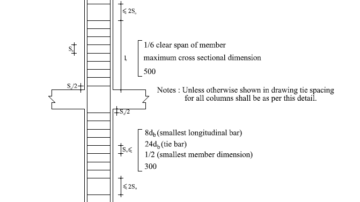First we need to focus on the Role of Stirrup or Tie bars in RCC column. Actions of tie bars as follows:
1. Ties are effective in restraining longitudinal bars from buckling out from their vertical alignment .
2. Ties hold rebar cages during construction process.
3. Ties provide confinement to the concrete core.
4. When Columns are subjected to lateral forces or columns need to resist the shear, then ties act as shear reinforcement for the columns.
So, Ties have important role on shear resistance for columns & confinement of long rebars. If ties are not provided properly to the columns then shear failure may happen. So proper design & accordingly size-spacing of ties must be maintained. Spacing of ties is calculated as per the plastic moment capacity of the column, induced moments in column because of strength of slab or due to earthquake loads.
ACI code has specific set of rules that defines the required strength of columns due to probable induced moments.
1.Check the earthquake or wind induced moments on columns.
2.Check for slab induced probable moments as well as the probable moment strength of column cross section. Minimum of the two will be governing, because if slab cannot apply more than x amount of moment then column will not be acted by any moment greater than x. And if “y” moment calculated from column’s cross section is less than the moment induced from slab, then column will crack and it will not carry any moments greater than its capacity.
3.Column’s shear strength should be governed from the maximum moment of the two cases mentioned above.

Ties are required more at the ends (closed stirrups/less spacing at ends compared to mid zone) to provide stronger confinement to long bars because the moments at the ends are greater & zero at mid zone.

And cracking zone of column lies upto L/4 distance from both of the column end (L=Length of column span one floor top to another floor bottom).

To reduce the chance of cracking we have to provide better or stronger confinement at the ends which ensures greater ductility and performance.

Leave a Reply
You must be logged in to post a comment.